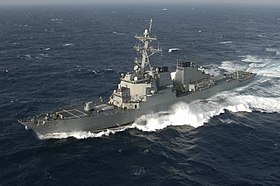USS Barry (DDG-52)
 Die Barry 2004 im Atlantik | |
| Übersicht | |
|---|---|
| Bestellung | 26. Mai 1987 |
| Kiellegung | 26. Februar 1990 |
| Stapellauf | 10. Mai 1991 |
| 1. Dienstzeit | |
| Indienststellung | 12. Dezember 1992 |
| Technische Daten | |
| Verdrängung | 8315 Tonnen |
| Länge | 154 m |
| Breite | 20 Meter |
| Tiefgang | 9,5 Meter |
| Besatzung | 26 Offiziere, 315 Mannschaften |
| Antrieb | 2 Propeller, über 4 Gasturbinen angetrieben; 100.000 Wellen-PS |
| Geschwindigkeit | 31 Knoten |
| Bewaffnung | 90 VLS-Zellen |
Die USS Barry (DDG-52) ist ein Lenkwaffenzerstörer der United States Navy. Sie gehört der Arleigh-Burke-Klasse an. Das Schiff ist nach John Barry benannt, der die USS United States während des Quasi-Krieges gegen Frankreich kommandiert hat.
Geschichte
Im September 1987 wurde der Auftrag über den Bau von DDG-52 erteilt. Im Februar 1990 wurde das Schiff als zweites ihrer Klasse auf Kiel gelegt, Bauwerft war Ingalls Shipbuilding. Im Mai 1991 lief der Zerstörer vom Stapel und wurde getauft. Im Dezember 1992 konnte die John Barry in Dienst gestellt werden.
Bereits in den ersten Jahren konnte das Schiff mehrere Preise gewinnen – allein drei Mal bis 1998 den Battenberg Cup. 1996 operierte der Zerstörer mit der USS George Washington (CVN-73) im Mittelmeer, wo die Kampfgruppe an der Operation Joint Endeavor teilnahm.
2003 beendete das Schiff eine Werftliegezeit in der Norfolk Naval Shipyard. 2005 fuhr sie im Krieg gegen den Terror neben USS Harry S. Truman (CVN-75) im Persischen Golf. Im Juli 2006 wurde die Barry eingesetzt, um bei der Evakuierung von amerikanischen Staatsbürger aus dem Libanon zu helfen. 2008 nahm sie an der Übung Sea Breeze im Schwarzen Meer teil. Am 23. Oktober legte die Barry im Schwarzmeerhafen der türkischen Stadt Samsun an. Von den lokalen Schleppern wurde der Zerstörer an die Pier bugsiert, als das Heck auf eine Sandbank lief und steckenblieb. Nachdem die Barry befreit wurde, untersuchten Taucher das Schiff, stellten aber keine Schäden fest.
Anfang 2011 verlegte die Barry an der Seite der USS Enterprise (CVN-65) in europäische Gewässer und weiter in den Indischen Ozean, wo die Gruppe zur Freihaltung der Seewege eingesetzt wurde. Anfang März 2011 verließ der Zerstörer die Gruppe und verlegte durch den Suezkanal ins Mittelmeer, um die amerikanische Präsenz vor Libyen zu verstärken; ihr folgten die USS Kearsarge (LHD-3) und die USS Ponce (LPD-15). Am 19. März feuerte der Zerstörer im Rahmen der Operation Odyssey Dawn Marschflugkörper vom Typ BGM-109 Tomahawk auf libysche Ziele ab.
Weblinks
- Eintrag im Naval Vessel Register (engl.)
- offizielle Homepage auf navy.mil (engl.)
Auf dieser Seite verwendete Medien
Atlantic Ocean (July 12, 2004) - The guided missile destroyer USS Barry (DDG-52) steams through the Atlantic Ocean while participating in Majestic Eagle 2004. Majestic Eagle is a multinational exercise being conducted off the coast of Morocco. The exercise demonstrates the combined force capabilities and quick response times of the participating naval, air, undersea and surface warfare groups. Countries involved in the NATO led exercise include the United Kingdom, Morocco, France, Italy, Portugal, Spain, and Turkey. Truman's participation in Majestic Eagle is part of her scheduled deployment supporting the Navy's new fleet response plan (FRP) Summer Pulse 2004, the simultaneous deployment of seven carrier strike groups (CSGs), demonstrating the ability of the Navy to provide credible combat across the globe, in five theaters with other U.S., allied, and coalition military forces.
The Flag of the United States Navy, as defined in Executive Order 10812 of April 24, 1959. The design is described there as:
The flag for the United States Navy is 4 feet 4 inches hoist by 5 feet 6 inches fly, of dark blue material, with yellow fringe, 2½ inches wide. In the center of the flag is a device 3 feet and 1 inch overall consisting of the inner pictorial portion of the seal of the Department of the Navy (with the exception that a continuation of the sea has been substituted for the land area), in its proper colors within a circular yellow rope edging, all 2 feet 6 inches in diameter above a yellow scroll inscribed "UNITED STATES NAVY" in dark blue letters.
The U.S. Navy flag is used for display purposes at ceremonies, parades, and other public functions where the U.S. Navy has an official presence, usually being carried by an honor guard on ceremonial occasions. It is not used for outdoor, fixed (permanent) purposes, and is not flown on Navy ships. Versions without fringe and different dimensions seem to be common, though it appears they are not technically the official U.S. Navy flag, as the executive order has not been amended.
Prior to 1959, the Navy Infantry Battalion flag was used to represent the U.S. Navy.
For more information, see the Navy's flag history page, SeaFlags, Flags of the World, U.S. Navy document NTP 13(B) [1], section 1710, and Navy regulation OPNAVINST 10520.1 (which replaced a similar SECNAVINST 10520.2D regulation from 1974).
